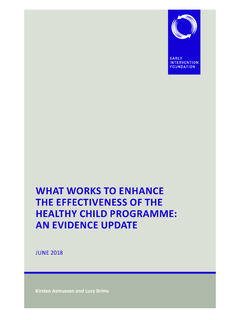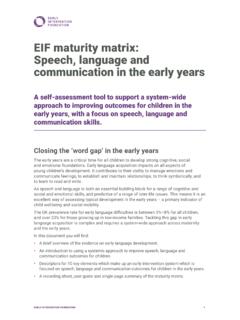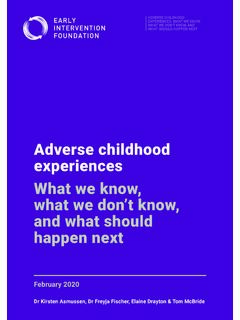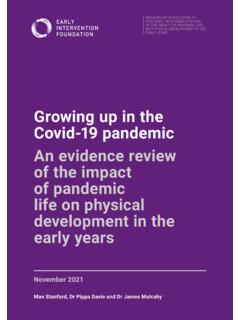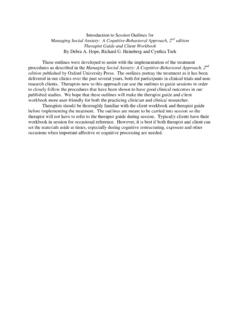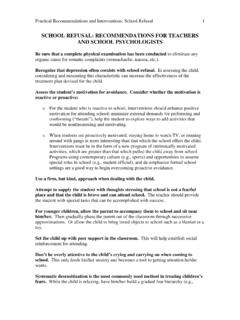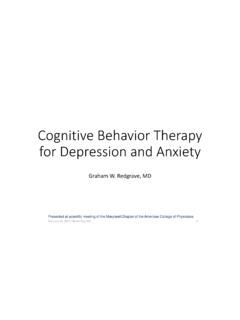Transcription of Revised Child Anxiety and Depression Scale (RCADS)
1 INTERNALISING BEHAVIOURS. Revised Child Anxiety and Depression Scale (RCADS). 47-item self-report for 8 18-year-olds The Revised Child Anxiety and Depression Scale (RCADS) is a 47-item measure designed to assess symptoms corresponding to Anxiety disorders and Depression in children and young people aged 8 18 years. The original measure includes six subscales aimed at assessing separation Anxiety disorder, social phobia, generalised Anxiety disorder, panic disorder, obsessive compulsive disorder and major depressive disorder. Test-retest Sensitivity to Internal consistency reliability Validity change ? . Psychometric features ( Scale ) (Subscale).
2 Brevity Availability Ease of Scoring Used in the UK. Implementation features . *Please note that our assessment of this measure is based solely on the English self-report version of the RCADS, for children and young people aged 8 18 years. The other versions of this measure were not assessed and therefore it should not be assumed that they would receive the same rating. What is this document? This assessment of the Revised Child Anxiety and Depression Scale (RCADS) has been produced by the Early Intervention Foundation (EIF) as part of guidance on selecting measures relating to parental conflict and its impact on children. To read the full guidance report and download assessments of other measures, visit: Some of the RCADS items contain sensitive content (for example item 37: I think about death').
3 If an individual raises issues around self-harm, suicide or related issues, they should either be referred to the relevant mental health services or the appropriate safeguarding procedures should be put in place. We found insufficient evidence to establish that the RCADS has good test-retest reliability over short periods of time. From our review of the evidence, it appears that the six subscales of the RCADS have a good validity, while that of the total score is questionable. We would therefore encourage you to use the individual subscale scores rather than the total score. Child OUTCOMES MEASURE: RCADS 1 EARLY INTERVENTION FOUNDATION | MARCH 2020.
4 About the measure Author(s)/ Publication year Type of measure developer(s) for the original Chorpita, , version of the Yim, L., Moffitt, C., measure Umemoto , &. Francis, 2000 Child self-report. Versions available There are three additional versions of this measure available, including a parent version (RCADS-P), a shortened 25-item Child self-report version and a shortened 25-item parent version. Outcome(s) This measure has been designed to assess Anxiety disorders assessed and Depression in children and young people. Subscales There are six subscales: separation Anxiety disorder (SAD), social phobia (SP), generalised Anxiety disorder (GAD), panic disorder (PD), obsessive compulsive disorder (OCD) and major depressive disorder (MDD).
5 The RCADS also yields a Total Anxiety Scale (sum of the five Anxiety subscales) and a Total Internalising Scale (sum of all six subscales). Purpose/primary use The RCADS measures the reported frequency of various symptoms of Anxiety and low mood. It was developed as a revision of the Spence Children's Anxiety Scale (SCAS). in order to correspond to the dimensions of some Anxiety disorders reported in the Diagnostic and Statistical Manual of Mental Disorders (DSM-5), and also include major Depression . In particular, the RCADS was intended to refine the measurement of generalised Anxiety disorder (GAD) to reflect core aspects of worry' (Wigham & Conachie, 2014).
6 Mode of This measure can be completed in person or online. administration Example item I worry about things.'. Target population This measure was originally developed for children aged 8 18 years. Child OUTCOMES MEASURE: RCADS 2 EARLY INTERVENTION FOUNDATION | MARCH 2020. Response format 4-point ordinal Scale (0 = Never', 1 = Sometimes', 2 = Often', 3= Always'). Strengths & Strengths: limitations The RCADS is a valid measure with good internal consistency. It is free to access and easy to score (the measure is available at: , with scoring instructions here: edu/resources/). Limitations: We found insufficient evidence to establish that the RCADS.
7 Has good test-retest reliability over short periods of time. The RCADS has 47 items and might require more than 15. minutes to be completed. According to our review, it does not appear that the RCADS. has UK cut-off scores. Link Contact details Bruce Chorpita: Copyright The English and translated versions of the RCADS are copyrighted by Chorpita and Spence. Any use of these instruments implies that the user has read and agreed to the terms of use. Neither the developers nor UCLA are responsible for any third-party use of these instruments by individuals who have not read the RCADS guide or its terms of use. While the RCADS can be used for research purposes, the developers ask, as a professional courtesy, to be informed of this before the study is conducted.
8 Finally, the use of RCADS. should always include acknowledgement of the development of the RCADS using appropriate scholarly citations, including the item development contributed by Spence (1997) and extensions by Chorpita et al. (2000). Key reference(s) Chorpita, , Yim, , Moffitt, C.., Umemoto , & Francis, (2000). Assessment of symptoms of DSM-IV Anxiety and Depression in children: A Revised Child Anxiety and Depression Scale . Behaviour Research and Therapy, 38, 835 855. Spence, (1997). Structure of Anxiety symptoms among children: A confirmatory factor-analytic study. Journal of Abnormal Psychology, 106, 280 297. Child OUTCOMES MEASURE: RCADS 3 EARLY INTERVENTION FOUNDATION | MARCH 2020.
9 Psychometric features in detail Internal consistency de Ross et al. (2002) reported an alpha coefficient of for the whole Scale . This study was conducted in Australia with a sample of . 405 children aged between 8 18 years (mean age = , ( Scale ). SD = ). We found a number of papers (Brown et al., 2013; Chorpita et al. 2000; Chorpita et al., 2005; Donnelly et al., 2019) reporting good internal consistency for the subscales of RCADS, with Cronbach's (Subscales) alpha values ranging from to De Ross et al. (2002) reported alpha coefficient values between and for the RCADS subscales. Donnelly et al. (2019) reported that the internal consistency for the RCADS subscales ranged from to This study was conducted in Ireland with a sample of 350 second-level students (186 female) aged between 12 18 years (mean age = , SD = ).
10 The majority of students identified themselves as White ( ). The developers (Chorpita et al., 2000) examined the subscales'. internal consistency and reported that all alpha coefficient values ranged between and This study was conducted in Hawaii with a sample of 246 children (137 females). The mean age was years and the major ethnic groups included were Filipino ( ), Japanese American ( ), Caucasian ( ), Hawaiian ( ) and Multi-ethnic ( ). In another study by the developers, Chorpita et al. (2005) examined the internal consistency of the subscales in a clinical sample and reported that all coefficient values ranged between and This study was conducted in Hawaii with a sample of 513 children (167 females) aged between 7 17 years referred for assessment to the University of Hawaii Center for Cognitive Behavior Therapy.
